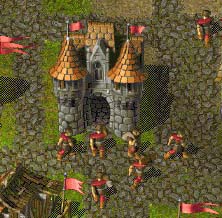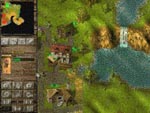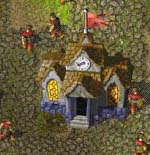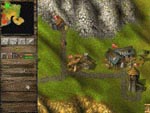 Oink-oink,
tip-tap--tip-tap, whirrrr, thunk: the sounds of a bustling medieval village. Knights and
Merchants, a real-time strategy title by Interactive Magic, provides you with the
opportunity to become immersed in village creation and maintenance. As the title implies,
Knights and Merchants (K&M) also offers some level of excitement by assigning various
military objectives that must be attained for victory. You are the last Captain of the
Guard, and you lead the remaining loyal troops in a desperate attempt to win back the
Kingdom from your Lord’s usurping son.
Oink-oink,
tip-tap--tip-tap, whirrrr, thunk: the sounds of a bustling medieval village. Knights and
Merchants, a real-time strategy title by Interactive Magic, provides you with the
opportunity to become immersed in village creation and maintenance. As the title implies,
Knights and Merchants (K&M) also offers some level of excitement by assigning various
military objectives that must be attained for victory. You are the last Captain of the
Guard, and you lead the remaining loyal troops in a desperate attempt to win back the
Kingdom from your Lord’s usurping son. In premise, this game sounds just like
every other real-time strategy title available since Dune 2. However, K&M is really
quite different in several ways. First, unlike most titles in the genre, it does not have
more than one type of race (as in Starcraft, Warcraft, and Age of Empires) or
"clan" (as in Command & Conquer, Dune, and Total Annihilation). This
translates to somewhat unimpressive combat as all units are identical on both sides, yet
it makes sense as the campaign is centered upon a civil war. This is another manner in
which K&M differs from its peers—your choices for play include a single-player
campaign and multi-player scenarios, but no random maps. Battles are fought with
formations of troops rather than individuals, and resource management is different from
the other games mentioned in many ways. Most importantly, the various buildings that are
required to obtain the best military units are integrated in a fascinating manner.
 In a very basic mission, you start out with a storehouse containing various
resources, as well as several serfs and laborers. Laborers may be instructed to work on a
project by merely designating what you want to build and where you want to build it. The
serfs will continuously bring the necessary materials (wood and stone) to the laborers as
their work progresses. Just as the display box claims, the building process is more
detailed than any other game that I have played—at times a new piece of framework is
installed with each fall of the hammer. Unfortunately, the level of detail also mandates
that you will spend a great deal of time during each game waiting for your serfs to bring
the appropriate construction materials to your laborers. And don’t make the mistake I
did by expecting a laborer or serf to perform a particular task by pointing and clicking!
This trait becomes particularly annoying when you have an important building project that
must be accomplished, but you unthinkingly set up some roadwork for your next
project—each laborer will then complete all of the road tiles prior to completing the
building that you had originally assigned! This can be a continual problem if you get
ahead of yourself, as almost every building that you complete is required to be connected
to your storehouse and inn by roads in order for serfs to service it.
In a very basic mission, you start out with a storehouse containing various
resources, as well as several serfs and laborers. Laborers may be instructed to work on a
project by merely designating what you want to build and where you want to build it. The
serfs will continuously bring the necessary materials (wood and stone) to the laborers as
their work progresses. Just as the display box claims, the building process is more
detailed than any other game that I have played—at times a new piece of framework is
installed with each fall of the hammer. Unfortunately, the level of detail also mandates
that you will spend a great deal of time during each game waiting for your serfs to bring
the appropriate construction materials to your laborers. And don’t make the mistake I
did by expecting a laborer or serf to perform a particular task by pointing and clicking!
This trait becomes particularly annoying when you have an important building project that
must be accomplished, but you unthinkingly set up some roadwork for your next
project—each laborer will then complete all of the road tiles prior to completing the
building that you had originally assigned! This can be a continual problem if you get
ahead of yourself, as almost every building that you complete is required to be connected
to your storehouse and inn by roads in order for serfs to service it.
 The detail of the buildings is very well (if too
cheerily) done, and after you train an appropriate worker for the building at the
schoolhouse, the building will become functional and the new resident will go about the
business of his craft. If he is a Woodcutter, he will immediately begin to chop down
trees, cut them down to size, and bring the timber back to his humble abode until a serf
appears to transfer the log to a sawmill. The serf will sling the log over a shoulder and
carry it to the sawmill, where a carpenter will plane it into lumber for constructing
weapons or buildings. A serf will then arrive once again to carry each piece of timber
either to the storehouse or to a final stage of processing, such as a Weapons Workshop.
The detail of the buildings is very well (if too
cheerily) done, and after you train an appropriate worker for the building at the
schoolhouse, the building will become functional and the new resident will go about the
business of his craft. If he is a Woodcutter, he will immediately begin to chop down
trees, cut them down to size, and bring the timber back to his humble abode until a serf
appears to transfer the log to a sawmill. The serf will sling the log over a shoulder and
carry it to the sawmill, where a carpenter will plane it into lumber for constructing
weapons or buildings. A serf will then arrive once again to carry each piece of timber
either to the storehouse or to a final stage of processing, such as a Weapons Workshop.
I really appreciated the complexity that this system brought into the game, until I
began to get tired of waiting through the increased time these transactions required.
Nonetheless, I am impressed that the status of nearly every building is evident to the
player without "entering" them. At the Bakery, the bread that is ready for
pick-up is displayed outside, while the Swine Farm displays the hide of a slaughtered pig
in one window and the carcass in another. Each worker can be seen at work (except in the
mines), and they do not work when the appropriate materials are not available to them. I
think that my personal favorite touch to this portion of the game is that the Woodcutter
will begin to replant saplings in an area once the existing timber is exhausted.
Reforestation to replenish a renewable resource—very impressive!
 Battles are fought on a somewhat larger scale than many other real-time
strategy games. You have control of how many units are in each formation, as well as which
direction the formation faces. You are limited to rectangular formations, however. The
units and their strengths seemed standard—the knights are the most powerful units
unless faced by pikes, while archers are devastating at long range yet useless in close
combat. Bonuses are given for units attacking from the side or rear, so some strategy is
occasionally useful. The battles were often interesting, and occasionally quite difficult.
My patience was sometimes tested by the amount of time that was required to accumulate the
horse, iron armor, iron sword, and recruit necessary to create just one knight, so I often
attacked prematurely. With some patience the battles were usually not too difficult, but
were often exasperating. Everything is in real time, so if you click incorrectly, an
entire troop can be rapidly wiped out. I was particularly distressed with the AI
controlling my archers, who continuously walked to a unit rather than shooting at it. I
understand that they required some space for their archery, but why didn’t they walk away
from the target instead of dangerously near it?
Battles are fought on a somewhat larger scale than many other real-time
strategy games. You have control of how many units are in each formation, as well as which
direction the formation faces. You are limited to rectangular formations, however. The
units and their strengths seemed standard—the knights are the most powerful units
unless faced by pikes, while archers are devastating at long range yet useless in close
combat. Bonuses are given for units attacking from the side or rear, so some strategy is
occasionally useful. The battles were often interesting, and occasionally quite difficult.
My patience was sometimes tested by the amount of time that was required to accumulate the
horse, iron armor, iron sword, and recruit necessary to create just one knight, so I often
attacked prematurely. With some patience the battles were usually not too difficult, but
were often exasperating. Everything is in real time, so if you click incorrectly, an
entire troop can be rapidly wiped out. I was particularly distressed with the AI
controlling my archers, who continuously walked to a unit rather than shooting at it. I
understand that they required some space for their archery, but why didn’t they walk away
from the target instead of dangerously near it?
I have learned to never judge a game that I am unfamiliar with by its display box art,
yet in this case the uninspiring box is a useful indicator. Knights and Merchants is a
very stable real-time strategy game with astounding detail in the resource allocation
arena. The graphics are pretty, but the integrated game-play is lacking. The campaign has
enough variety to be intriguing, but it would be nice to play the occasional short
scenario against the computer. Wwhhaaaap! The sound of the CD case closing on Knights and
Merchants, with significant finality…
--Jeffrey W. Peterson
